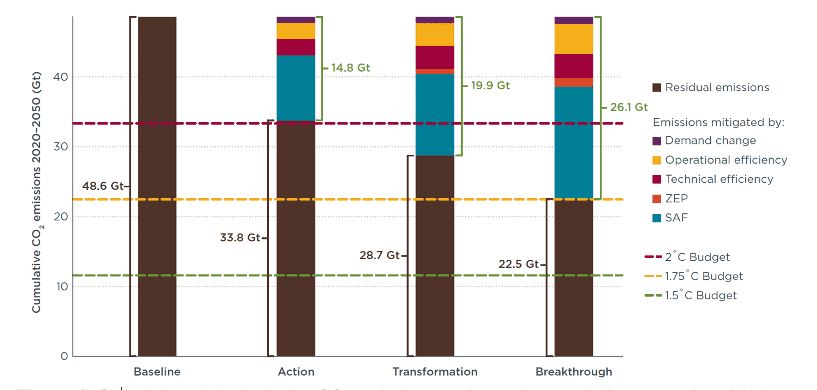CO2 emissions from commercial aviation: 2013, 2018, and 2019
Report
Vision 2050: Aligning aviation with the Paris Agreement
Airlines and governments have committed to achieving net-zero emissions from aviation by mid-century. In this report, we develop a roadmap to evaluate the emission impacts of ICCT scenarios for aviation technology and operations using a new Projection of Aviation Carbon Emissions (PACE) model. Our goal is to assess the extent to which measures can reduce cumulative carbon dioxide (CO2) emissions from global aviation in line with 1.5°C, 1.75°C, and 2°C targets.
Three decarbonization scenarios—Action, Transformation, and Breakthrough—are analyzed along with a Baseline scenario, each built around six important parameters: (1) traffic; (2) aircraft technology; (3) operations; (4) zero-emission planes (ZEPs); (5) sustainable aviation fuels (SAFs); and (6) economic incentives.
Detailed findings of the study include:
- In the most ambitious (Breakthrough) scenario, early and sustained government intervention triggers widespread investments in zero-carbon aircraft and fuels, peaking fossil jet fuel use in 2025 and zeroing it out by 2050. Aviation CO2 is cut by more than 90% below 2019 levels in 2050; cumulative emissions are consistent with 1.75ºC pathway under which aviation doesn’t increase its share of a global carbon budget.
- SAFs account for the largest share of CO2 reduction potential, varying between 59% and 64% across scenarios. Improvements in aircraft technical and operational efficiency contribute an additional one-third of CO2 mitigation. Zero-emission planes powered by hydrogen account for up to 5% of emission reductions in 2050.
- Under all scenarios, fuel and ticket costs rise along with the introduction of SAFs. Under the Breakthrough scenario, fuel costs increase by 34% and 70% in 2030 and 2050, respectively, due to the adoption of these more expensive fuels. Thus, policies like a SAF mandate, low carbon fuel standard, carbon taxes, and/or a frequent flier levy will be needed to bridge the price gap between alternative and fossil jet fuels.
Overall, we conclude that new technologies under development can cut aviation CO2 to near zero in 2050, but that immediate action is needed from governments to peak emissions this decade to put aviation on a 1.75ºC pathway. Either atmospheric carbon removals or curbs to traffic growth will be needed to meet a 1.5ºC temperature pathway.

Figure. Cumulative global aviation CO2 emissions under various modeling scenarios, 2020-2050
This paper was revised on 30 June, 2023 to correct captions on Figures 10 (ES-2) and B-1 and to amend an estimate of projected ticket price increases. After taking into account fuel efficiency gains through 2050, ticket prices are expected to rise by about 6% under the Breakthrough case. The original can be found here.
